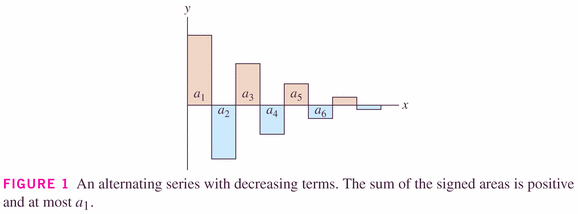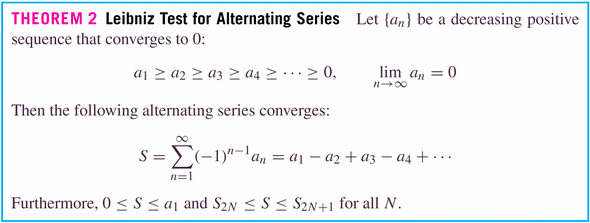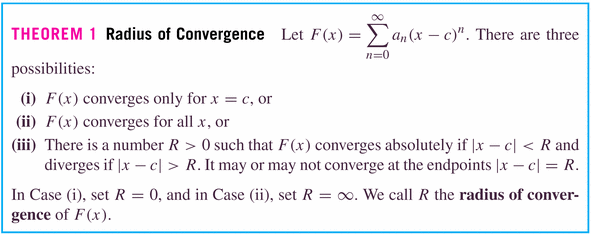- Your exams (revised and original) are due today.
- Your 11.3 homework is due tomorrow.
- Today we'll wrap up 11.5, and start 11.6.
-
Once again, our mission here is not necessarily the value of the
series, but may be simply knowledge of whether it converges or
not.
- How does the author of this image reach the conclusion that "the sum is positive and at most
"?
- How about the partial sums --
-- what are they doing?
- What are the even partial sums doing?
- What are the odd partial sums doing?
- Examples:
- The alternating harmonic series is convergent
(Example 1, p. 753).
We need to show that the terms
of the series satisfy the Leibniz test:
- the terms are positive,
- the terms are decreasing in size,
- the terms have limit of 0.
- #5, p. 755
Identify the terms
, and decide whether they satisfy the Leibniz test.
- #13
- #17
Remember that for convergence, the conditions of the test need be true only eventually: convergence is all about the tail, not the head of the sequence.
- #23
For this one, we need the "Alternating Series Estimation Theorem" (p. 754):
- #27
- #34
- The alternating harmonic series is convergent
(Example 1, p. 753).
That being said, a theorem below does give us some help in determining the value of (or at least bounds on the value of) the series of a type called an "alternating" series. In particular, we want to look at alternating series like the one below:

So it turns out that if the terms are converging to 0, then the alternating sequence converges to a limit.
Now we usually write our alternating series in the following way, illustrated by Leibniz's test: we assume that the are positive, and the term
takes care of the "alternation". (Our textbook switches to
for the positive part of the term.)

Our textbook calls this the "Alternating Series Test" (p. 751). The "Furthermore" part our textbook calls the "Alternating Series Estimation Theorem" (p. 754).
- First, a definition:

- Series that converge absolutely, and
- Series that don't.


- Examples:
- #5, p. 761
- #12, p. 761
- It turns out that conditionally convergent series can have their terms rearranged to converge to any limit you like (let's take a look at "Rearrangements", on p. 761). Hmmm.... Is this the end of commutativity?!
- The Ratio and Root Tests
- There are two main tests for convergence of series in this section:

This result says that eventually the ratio of successive terms is effectively constant,
: the terms of the sequence approach a "common ratio" as
. What kind of series looks like that? A geometric series:
Examples:
- #2, p. 761
- #3, p. 761
The ratio test is effectively a self-referrential comparison test: we compare terms of
with other terms
(rather than with some other series).
Here's a test that is also self-referrential, but only looks at a single term -- the root test:

This result says that eventually the absolute values of the terms are effectively equal to
: what kind of series looks like that? A geometric series!
No wonder the results of the tests look exactly the same.... Too bad we didn't just use the same letter for the limits in both cases. Stewart is better -- he does!
Notice that, once again, limits of sequences plays an important role! Series are just sums of sequences, after all; we're focused on how terms behave (root test), how successive terms behave (ratio test), or how partial sums behave.
Examples:
- #7, p. 761
- #13, p. 761
- There are two main tests for convergence of series in this section:
- Any more questions?
- Summary:
Now, rather than simply infinite sums of numbers, we're going to
consider an infinite sum of functions in what are known as
power series. They're like polynomials, but they don't
have finite degree.
The terms will be monomials -- constants times powers of x.
Now we realize that, with functions for terms, each value of x specified gives rise to an infinite series, and we might immediately wonder if the series is convergent.
So what kind of function has an infinite number of terms? How do you evaluate such a thing? What kinds of function are these? It turns out that a lot of our old friends can be expressed this way
,
Now what did we assert about
? That
For what values of x would this converge?
Let's take a look at how well a truncated power series -- a partial sum -- approximates the real function.
- Graph
on the interval [-2,2].
- Graph
- Graph
- Graph
Apply the ratio test for arbitrary x, and what do you discover?

So
presents us with a case where we have an "infinite radius of convergence".
Interesting sidelight: you may have encountered Euler's Formula at some point in your life:where
. From this (and the power series for
) we can now deduce power series for the functions cosine and sine. Let's do that.
Let's look at an example where our radius of convergence is not so nice: consider
. One can show that
.
Now: for what values of x do you think that this will converge?


Note that this is a variation on the theme of the ratio test: we don't consider the power terms, but only the coefficients.
- Graph
- Examples:
- What does Theorem 2 say will be the radius of
convergence of the series for
?
- What about the endpoints?
- How well do the truncated partial sum functions approximate
?
- #7, p. 769
- #19
- #27
- What does Theorem 2 say will be the radius of
convergence of the series for